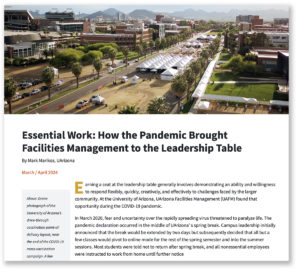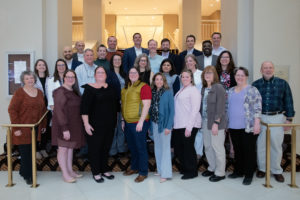Educational campuses abound with assets and resources, from their beautiful buildings and sophisticated technologies to the brilliant minds of the scholars who learn and teach at them. Too often overlooked in that appreciation, as every APPA member knows, are the professionals who plan, create, manage, maintain, and continually improve these campuses.
This Facilities Manager focuses on the “seat at the table” facilities management (FM) must have for educational institutions to fulfill their fullest potential as learning environments.
 In his cover story on how the covid-19 pandemic brought FM to the leadership table at the University of Arizona, for example, Mark Marikos outlines the FM department’s emphasis on communicating, collaborating, anticipating, and innovating during that difficult time, including managing a massive vaccination effort that served 243,000 people. “The experience was immensely gratifying, uniting us as part of a larger team and putting our abilities and customer service attitude on open display, cementing our relationships with other entities around the university and broader community,” Marikos writes.
In his cover story on how the covid-19 pandemic brought FM to the leadership table at the University of Arizona, for example, Mark Marikos outlines the FM department’s emphasis on communicating, collaborating, anticipating, and innovating during that difficult time, including managing a massive vaccination effort that served 243,000 people. “The experience was immensely gratifying, uniting us as part of a larger team and putting our abilities and customer service attitude on open display, cementing our relationships with other entities around the university and broader community,” Marikos writes.
Another illustration of FM solidifying its place at the decision-making table is Glen Haubold’s account of his years at New Mexico State University. Through strategic steps forward and an always-on desire to learn, the FM department progressed from being viewed as “maintenance” to routinely seating its leaders on ad hoc committees, leading capital request meetings, overseeing strategic planning, serving on reaccreditation writing teams, and more.
The topic also permeated APPA’s 2024 Thought Leaders Symposium, which took place just before this magazine was published. Embedded into discussions about the impact of artificial intelligence (AI) and other advances on the campus environment of the years ahead was an implicit awareness that none of them matter without the professionals to integrate them into the buildings and infrastructures that support them.

Attendees of APPA’s 2024 Thought Leaders Symposium, February 26-28 in Alexandria, Virginia.
As symposium participant Jamie Gayer noted, “it’s really important that the other areas of the higher education infrastructure understand how facilities truly impact the everyday operation of the higher ed experience.” When considering institutions’ future needs, Gayer, senior human relations director at Indiana University Bloomington, believes what’s “most critical is that those who are sitting at the decision-making table … ensure that the voices being heard represent the full demographic of who helps make this campus the place is for our students, for researchers to do the amazing work they do, for faculty to teach, for staff to be able to support the environment. It comes down to being intentional and purposeful about the way our teams are structured … and who’s at the table … [and asking], is that the right individual to speak on behalf of that function or that topic?”
So, let us ask you: Is your FM team at your institution’s decision-making table? If so, we’d love to hear (and possibly publish!) your story—how you got there, how you maintain your seat, and some of the outcomes you’ve helped achieve while in it. Please email us at [email protected].
Leah Thayer is APPA’s director of publications and the editor of Facilities Manager. She can be reached at [email protected].
Coming in the next Facilities Manager:
- When three universities become one
- Ever adapting to a changing student body


